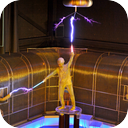(short preview of full seamless looping track)
(short preview of full seamless looping track)
(short preview of full seamless looping track)
(short preview of full seamless looping track)
(short preview of full seamless looping track)
Electrical Pulse
This product is not available in the selected currency.
In Stock
Backordered
Out of Stock
Description
The slightly blue, blazingly hot stream of sizzling electricity swims right through the cautious conduit, creating the most spectacular and dangerous example of the power of power that there ever could be. You sit safely to the side, satisfied that you are far enough away from the million watts that you can pull out a can of coke and quench your raging thirst, however just as you swing your head back for a gulp, you feel a strange pull upon the frame of your glasses. Electrical phenomena have been studied since antiquity, though advances in the science were not made until the seventeenth and eighteenth centuries. Practical applications for electricity however remained few, and it would not be until the late nineteenth century that engineers were able to put it to industrial and residential use. The rapid expansion in electrical technology at this time transformed industry and society. Electricity's extraordinary versatility as a source of energy means it can be put to an almost limitless set of applications which include transport, heating, lighting, communications, and computation. Electrical power is the backbone of modern industrial society, and is expected to remain so for the foreseeable future. Ancient cultures around the Mediterranean knew that certain objects, such as rods of amber, could be rubbed with cat's fur to attract light objects like feathers. Thales of Miletos made a series of observations on static electricity around 600 BC, from which he believed that friction rendered amber magnetic, in contrast to minerals such as magnetite, which needed no rubbing.
Opps
Sorry, it looks like some products are not available in selected quantity.



